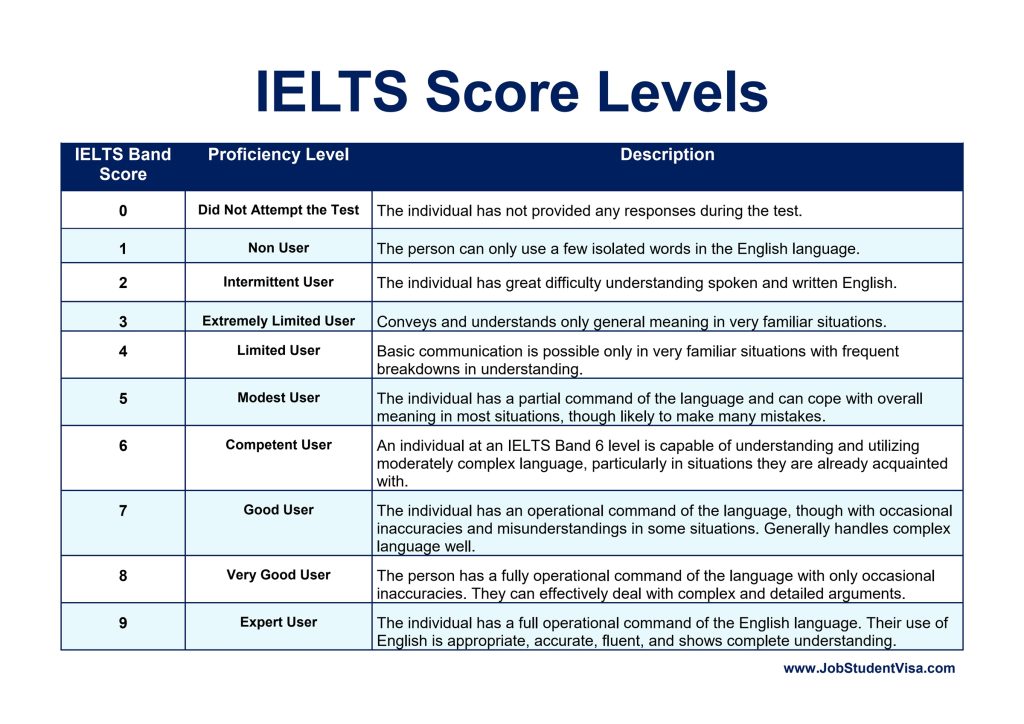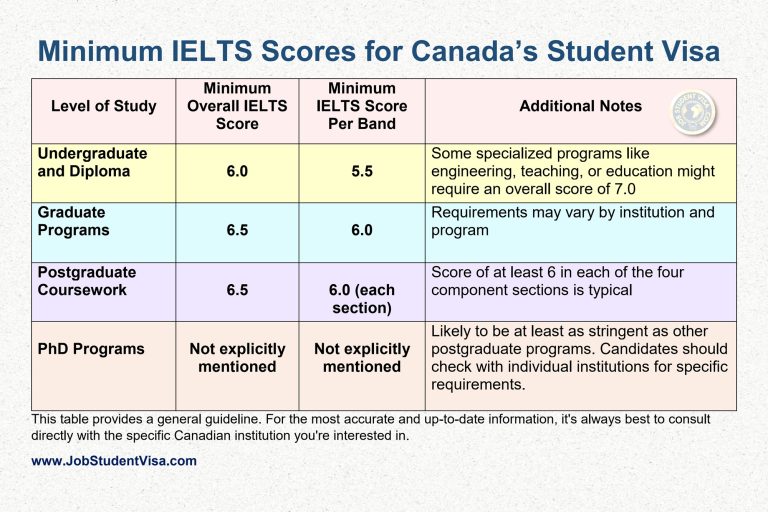What are the IELTS Scores, Levels, and Test Types ?
The International English Language Testing System, commonly known as IELTS, is widely recognized as a comprehensive evaluation of English language proficiency at a global level. Divided into various levels, IELTS aims to evaluate a candidate’s ability to communicate effectively in English across four key language skills: listening, reading, writing, and speaking. In this article, we’ll explore the different levels of IELTS and understand what each level entails.
What Are the IELTS Scores, Their Levels, and the Different Test Types?
In this comprehensive guide, we delve into the intricacies of the International English Language Testing System (IELTS), highlighting the distinct levels, scoring system, and the different types of tests available. The article aims to clarify the nuances of each IELTS band score, ranging from the expert user to the non-user, and explains how these scores align with language proficiency levels. Furthermore, it differentiates between the Academic and General Training versions of the test, outlining their specific purposes and content focus. Special attention is given to the IELTS tests tailored for UK Visas and Immigration, including the IELTS for UKVI and IELTS Life Skills tests. This guide serves as an essential resource for individuals preparing for the IELTS, whether for academic, professional, or immigration purposes.
IELTS Test Types
1. IELTS Academic
Designed for individuals seeking admission to higher education institutions or professional registration, IELTS Academic assesses a candidate’s ability to comprehend and use complex academic language. The test includes reading passages from academic texts, writing tasks with an academic focus, and questions that evaluate a candidate’s ability to engage in academic discussions.
2. IELTS General Training
This level is intended for individuals planning to migrate to an English-speaking country for work, training programs, or secondary education. IELTS General Training focuses on practical, everyday English language skills. The test includes topics related to work, social situations, and general topics of interest. It assesses the candidate’s ability to understand and respond to information, express ideas clearly, and communicate effectively in a variety of contexts.
3. IELTS Life Skills
IELTS Life Skills is a unique level designed for those who need to prove their English language speaking and listening skills for UK visa applications. It includes tasks that assess the ability to handle everyday communication in English, such as discussing familiar topics, expressing opinions, and understanding instructions.
4. IELTS for UK Visas and Immigration:
Specifically tailored for individuals applying for visas to the United Kingdom, this level evaluates English language proficiency in listening and speaking. It focuses on the ability to communicate in real-life situations, such as conversations with immigration officers, healthcare professionals, or landlords.
5. IELTS Indicator
Introduced in response to the COVID-19 pandemic, IELTS Indicator is an online test that allows candidates to take the test from the comfort of their homes. It assesses the same four language skills as the traditional IELTS test, making it a convenient option for those facing travel restrictions or other challenges.
Understanding the different levels of IELTS is crucial for candidates to choose the right test based on their goals and needs. Whether pursuing higher education, professional registration, or migration, IELTS provides a comprehensive evaluation of English language proficiency. As you embark on your IELTS journey, consider the specific requirements of each level to ensure you are well-prepared for success in your endeavors.
IELTS Score Levels
The International English Language Testing System (IELTS) is renowned for evaluating English language proficiency, assigning scores that reflect a candidate’s abilities in listening, reading, writing, and speaking. Understanding the score levels is crucial for candidates as it provides insights into their language skills. In this article, we will delve into the various score levels of IELTS and what each level signifies.
IELTS employs a scoring system ranging from 0 to 9, with half-band increments. These scores are mapped to different proficiency levels. A score of 9 indicates an expert user, while a score of 1 reflects a non-user. The scores in between represent various degrees of proficiency.
IELTS 0 Level
- Description: Did not attempt the test. The individual has not provided any responses during the test.
IELTS 1.0 Level
- Description: Non-user. The person can only use a few isolated words in the English language.
IELTS 2.0 Level
- Description: Intermittent user. The individual has great difficulty understanding spoken and written English.
IELTS 3.0 Level
- Description: Extremely limited user. Basic communication is possible only in very familiar situations with frequent breakdowns in understanding.
IELTS 4 .0 Level
- Description: Limited user. The person’s basic competence in English is limited to familiar situations. They often have problems in understanding and expression.
IELTS 4.5 Level
- Description: This level indicates a slightly better understanding and expression in familiar situations than a pure level 4. It’s a transitional score between limited and modest user.
IELTS 5.0 Level
- Description: Modest user. The individual has a partial command of the language and can cope with overall meaning in most situations, though likely to make many mistakes.
IELTS 5.5 Level
- Description: Represents a competence that is halfway between the modest and competent user levels. This level indicates an ability to handle basic communication in their field with some confidence.
IELTS 6.0 Level
- Description: Competent user. The person has an effective command of the language despite some inaccuracies and misunderstandings. An individual at an IELTS Band 6 level is capable of understanding and utilizing moderately complex language, particularly in situations they are already acquainted with.
IELTS 6.5 Level
- Description: This level suggests a more solid proficiency than a straightforward level 6, showing that the individual is closer to being a good user, particularly in familiar contexts.
IELTS 7.0 Level
- Description: Good user. The individual has operational command of the language, though with occasional inaccuracies and misunderstandings in some situations. Generally handles complex language well.
IELTS 7.5 Level
- Description: This score is indicative of a person who is between a good and a very good user, able to handle complex language and understand detailed reasoning more effectively.
IELTS 8.0 Level
- Description: Very good user. The person has a fully operational command of the language with only occasional inaccuracies. They can effectively deal with complex and detailed arguments.
IELTS 8.5 Level
- Description: Reflects an advanced language skill, nearing complete command of the language. This score suggests minor lapses in usage but overall excellent proficiency.
IELTS 9.0 Level
- Description: Expert user. The individual has a full operational command of the English language. Their use of English is appropriate, accurate, fluent, and shows complete understanding.
Here’s a table summarizing the IELTS band scores and their corresponding English language proficiency levels:
| IELTS Band Score | Level | Description |
|---|---|---|
| 0 | Did not attempt | The test-taker did not answer the questions. |
| 1 | Non-user | Has no ability to use the language except a few isolated words. |
| 2 | Intermittent user | Great difficulty understanding spoken and written English. |
| 3 | Extremely limited user | Communicates and understands only general meaning in very well-known situations. Frequent breakdowns in communication. |
| 4 | Limited user | Basic competence limited to familiar situations. Problems in understanding and expression. Not able to use complex language. |
| 4.5 | Between limited and modest user | Slightly better understanding and expression in familiar situations than a pure level 4. |
| 5 | Modest user | Partial command of the language, coping with overall meaning in most situations, although likely to make many mistakes. |
| 5.5 | Between modest and competent user | Better ability to handle basic communication in their field with some confidence. |
| 6 | Competent user | Effective command of the language despite some inaccuracies, misunderstandings. Can use and understand fairly complex language. |
| 6.5 | Between competent and good user | Closer to being a good user, particularly in familiar contexts. |
| 7 | Good user | Operational command of the language, though with occasional inaccuracies, inappropriate usage, and misunderstandings in some situations. Generally handles complex language well. |
| 7.5 | Between good and very good user | More adept at handling complex language and understanding detailed reasoning. |
| 8 | Very good user | Fully operational command of the language with only occasional inaccuracies. Handles complex and detailed argumentation well. |
| 8.5 | Between very good and expert user | Advanced language skill, nearing complete command of the language. Minor lapses in usage but overall excellent proficiency. |
| 9 | Expert user | Full operational command of the language. Appropriate, accurate and fluent use of language, showing complete understanding. |
This table is based on the general guidelines provided by IELTS and offers an overview of what each score level represents in terms of English language proficiency. [Source]
Depending on the purpose of taking IELTS, different score levels may be required. For example, universities may have specific score requirements for admission, and immigration authorities may have different thresholds for visa applications.







